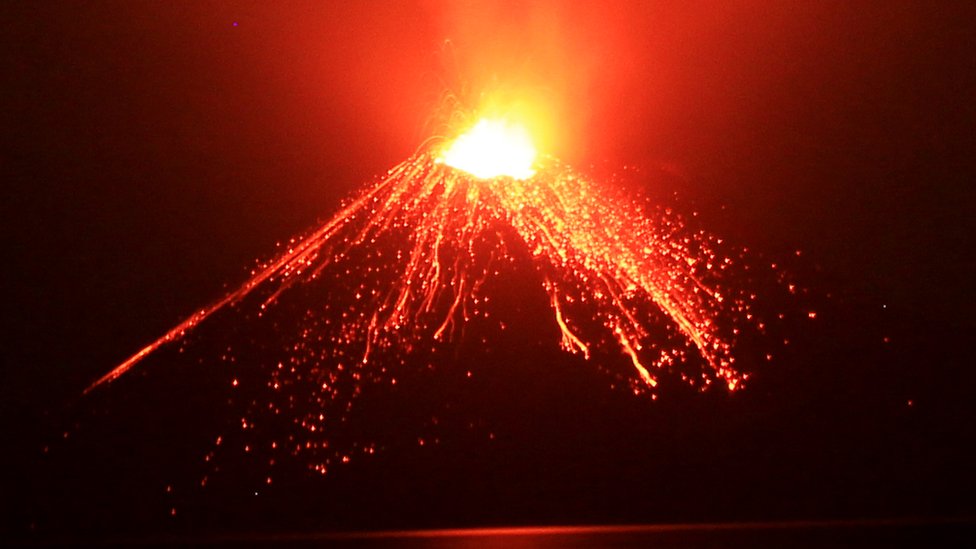INSUBCONTINENT EXCLUSIVE:
Image copyrightEPAImage caption
The death toll after Saturday's tsunami continues to rise
It is very
likely that a collapse of rocks on Indonesia's Anak Krakatau volcano caused an undersea rockslide, which in turn generated a tsunami on
Saturday that has claimed hundreds of lives.The volcano is now entering a new, deadly phase, writes California-based volcanologist Jess
Phoenix as she looks at a series of spectacular images to analyse the timeline of eruptions.Image copyrightGetty ImagesIn the illustration
above, we see Krakatau volcano (also known as Krakatoa) from before its infamous 1883 eruption
The name "Anak Krakatau" means "Child of Krakatau," so this look at the modern volcano's predecessor provides perspective for scientists
Krakatau was a classic cone-shaped stratovolcano (meaning it was made of layers and layers of erupted material) that appeared to be intact
The presence of the fishing vessel in the illustration indicates that despite what appears to be a small steam plume rising from the top,
there were no worries about danger from the volcano.A steam plume would be normal for a volcano that is not erupting and is caused by water
heated inside of the volcano rising to the surface.Image copyrightGetty ImagesThis image, taken in July 2018, is of a small eruption of Anak
Krakatau, likely one that would be classified as a 0 or 1 on the Volcanic Explosivity Index
That scale measures the amount of material erupted from a volcano and increases exponentially, with 0/1 being typical of Hawaiian eruptions,
and 8 being cataclysmic, like the eruption of Yellowstone 630,000 years ago
These types of eruptions can occur as often as daily over the course of years without resulting in a larger eruption
However, it is possible that if more magma enters the system, the volcano will erupt on a larger scale.Image copyrightGetty ImagesIn this
photo, also from July 2018, we see incandescent material being ejected from Anak Krakatau's summit crater
The visible glow shows the material is still quite hot, as it will cool to a black colour with time
The material is cooling magma, and can form cinder, small fragments of lava known as lapilli, and larger objects called lava bombs
These are all dangerous to humans, and lava bombs can travel hundreds of metres from the volcano's summit vent before hitting the
ground.Image copyrightGetty ImagesThis aerial image from August 2018 shows Anak Krakatau as a small island mostly covered by ejected
It sits in the middle of a rough circle of three other islands which make an approximate boundary of where the original Krakatau volcano was
The 1883 eruption caused a massive collapse of the major structures of Krakatau, and Anak Krakatau has been building up from the collapsed
area since it breached sea level in 1930
This image documents a weak eruption plume and relatively fresh materials on the island.Image copyrightEPABy contrast, this aerial photo
from September 2018 shows a vastly different situation than that of the previous image
A thick brown eruption column obscures one of the three boundary islands, and it shows evidence of convection, which can be seen this
picture in its changing width
Eruption columns pose a threat to air traffic and human health, as they are composed of rock fragments that cause damage if inhaled by
These rock fragments can also cause the collapse of buildings due to their weight.Image copyrightReutersThis stunning photo from 23 December
2018 shows a dramatic contrast between the Anak Krakatau of today and the one we saw just a few short months ago
The cone itself is obscured by the violent eruption, with the interaction between superheated magma, gas, and water causing explosions that
result in the water flashing to steam
Since Anak Krakatau is surrounded by water, there is even greater interaction of water and hot volcanic materials, which produces more steam
and a messy-looking eruption.Image copyrightReutersVolcanoes can create their own lightning, as this Anak Krakatau image also taken on 23
The mid-air collision of fragmented rock, volcanic ash, and water can create a static charge
The volcano itself is obscured by the eruption column
The lightning does not come down from storm clouds, but rather from the eruption column itself discharging the static energy through a
process called charge separation.Of course, volcanoes don't erupt in a vacuum
Their impacts are felt locally, and sometimes regionally or globally
The new phase of eruptive activity of Anak Krakatau has come with an unusual tragedy in the form of a tsunami
With the data currently available, it appears that the tsunami that hit the western end of the island of Java may have been the result of a
collapse of part of Anak Krakatau that triggered an underwater rockslide
That displacement of rock likely generated the deadly tsunami, some effects of which are pictured above
Volcanic hazards are not new to Indonesia, and the effects of the latest eruption of Anak Krakatau should serve as a reminder that we need
additional study, education, and preparedness measures to keep people and property safe during volcanic disasters and their aftermath.Jess
Phoenix is a US volcanologist, co-founder of environmental research non-profit Blueprint Earth, and a Fellow of the Royal Geographical

